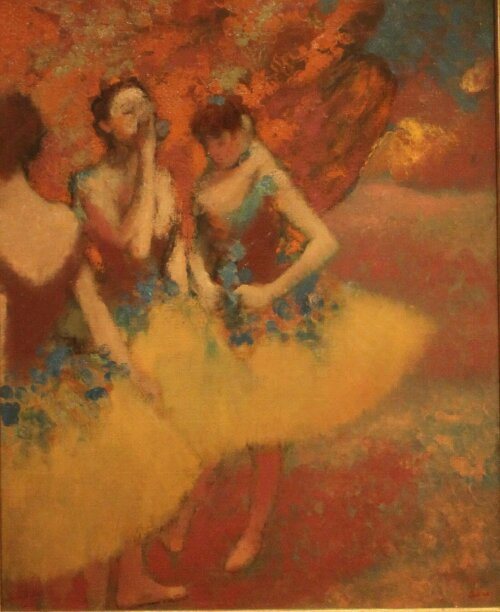
Edgar Degas
French, 1834-1917
Three Dancers in Yellow Skirts, 1891, ca.
oil on canvas
32 × 25 5/8 in.
Michael Armand Hammer and the Armand Hammer Foundation
Loan

Edgar Degas, Self-portrait, Oil on paper, ca. 1855–56
"No art is less spontaneous than mine. What I do is the result of reflection and the study of the great masters." - Edgar Degas
COMMENTS
This picture is similar in size and conception to the Louvre’s Dancers in Blue, which is closely related to the Metropolitan Museum’s Dancers in Red and Green. The Louvre picture, in blue-green-purple and the Hammer picture, in red-yellow-orange, seem, in fact, to be coloristic variations on the same theme. Degas experimented at this time with broadly stippled backgrounds in other pictures, notably in his studies of dancers and of bathers. The placement of the figures suggests the same or similar poses seen from different angles of vision, a device increasingly exploited by Degas. Along with his interest in different poses arranged sequentially, the resulting photocinematic effect certainly reflects Degas’ knowledge of early experiments in motion photography. This effect is enhanced by the suggestion of an unstable equilibrium resulting from the eccentric arrangement of the figures. The entire composition is stabilized by Degas’ manipulation of his hues and their values.
- The Armand Hammer Collection: Five Centuries of Masterpieces, Los Angeles, 1981
The theme of the dancer, caught in a characteristic moment, is also found in one of Degas’ best sonnets:
She dances, dying. As around the reed
Of a flute where the sad wind of Weber plays,
The ribbon of her steps, twists and knots,
Her body sinks and falls in the movement of a bird.
The violins sing. Fresh from the blue of the water
Silvana comes, and carefully ruffles and preens:
The happiness of rebirth and love on her cheeks,
In her eyes, on her breasts, on her whole new being . . .
And her satin feet, like needles embroider
Patterns of pleasure. The springing girl
Wears out my poor eyes, straining to follow her.
With a trifle, as always, the beautiful mystery ends.
She bends back her legs too far in a leap,
It’s the leap of a frog in the Cytherean pond.
- Daniel Catton Rich, Director, The Art Institute of Chicago, 1951
SBMA CURATORIAL LABELS
Although Degas exhibited with the Impressionists, he did not share their interest in working outdoors to capture fleeting effects of light and atmosphere, preferring to concentrate on the human figure. Ballet dancers, either on stage or behind the scenes, were a favorite subject. This painting of young dancers was made late in his career and displays his use of vibrant color, his interest in creating textural effects through an unconventional paint application, and his daring sense of composition. Degas was influenced by the Japanese woodblock prints – the dancers’ poses form a sequence of movement, and the left figure is cropped. We encounter not only the hardworking and exhausted bodies of these adolescent girls – even at rest, their feet are turned out in the correct ballet posture – but also the psychological tension in their preparations for the performance.
- Ridley-Tree Gallery, 2016
